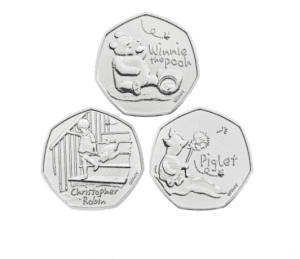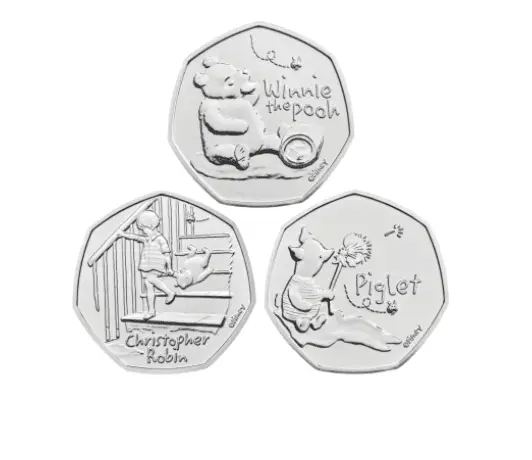The Winnie the Pooh coins are uncirculated, which means they are worth the price that they are sold at. You can check the prices directly at the Royal Mint’s shop here.
Although not the most collectable 50p coins out there, the Winnie the Pooh 50ps do make for great presents and come in a variety of finishes depending on what you’re looking for.
In this article, we’ll jump more in-depth about the different designs of the Winnie the Pooh 50ps, as well as how many there are and much more.
How many Winnie the Pooh 50p coins were made?
The three 2020 Winnie the Pooh commemorative 50p coins are part of a planned 6-coin release in 2020 and 2021 and are the first series of British coins to feature A. A. Milne’s beloved characters.
None of the Winnie the Pooh 50p coins have been released into general circulation. Each coin has a brilliant uncirculated, silver proof standard, silver proof coloured and gold proof release:
| Coin | Version | Mintage |
| Winne the Pooh | BU | 45,000 |
| Silver proof | Unknown | |
| Silver proof (coloured) | 18,010 | |
| Gold proof | 535 | |
| Christopher Robin | BU | 45,000 |
| Silver proof | Unknown | |
| Silver Proof (coloured) | 18,010 | |
| Gold proof | 535 | |
| Piglet | BU | 45,000 |
| Silver proof | Unknown | |
| Silver Proof coloured | 18,010 | |
| Gold proof | 535 |
The design of the Winnie the Pooh 50p coins

The obverse of the coin features the 2020 coinage portrait of the Queen by Jody Clark, the first Royal Mint employee to create a portrait in 100 years – the practice is usually completed by artists working outside of the Mint. The inscription ‘ELIZABETH II.D.REG.F.D.50 PENCE.2000’ appears around the portrait. Ordinarily, the denomination appears on the reverse face of the coin, but the Winnie the Pooh coins feature it on the portrait side.
Each reverse face has its own unique design, featuring one of the books main characters – Winne the Pooh himself, Piglet and Christopher Robin. All were designed by Royal Mint coin designer, Daniel Thorne. Speaking in 2020, Daniel Thorne said ‘Winnie-the-Pooh was a huge part of my childhood and forms some of my fondest memories. I wanted to make sure this series of coins truly encapsulated the spirit of Pooh Bear and all his friends.’
Each coin is a recreation of the original book illustrations by E. H. Shepard. The Winnie the Pooh coin features the books eponymous character sitting down next to a jar of honey – the food that he is forever associated with – whilst a bee flies over his head. The silver proof version has him coloured in golden yellow, and the barrel in brown.
For Piglet’s coin, Pooh’s best friend is sat on grass, blowing petals off a dandelion, whilst a bee flies by. In the coloured version, Piglet’s jumper is green, the dandelion is in yellow, the grass is green and the bee is accented in black and yellow.
Christopher Robin’s coin features an illustration of the boy carrying a Winnie the Pooh toy down the stairs of his house, with the ubiquitous bee flying behind him. The coloured version has Christopher in a blue and white checked shirt, the stair carpet in red and Pooh in his usual golden yellow colour.
All versions of every coin have the Disney copyright symbol on the bottom right – the company won the rights to Poohs usage in 2019 – and the character’s name engraved next to their illustration in a child-like font.
Why was it made and what does it commemorate?
Winnie the Pooh is a creation of the English author, Alan Alexander Milne.
Milne was born in Kilburn, London, in 1882, and was once taught by another grandee of English literature, the novelist H. G. Wells. Milne was a keen cricketer and, quite astonishingly, played on the same cricket team as J. M. Barrie, Arthur Conan Doyle and P. G. Wodehouse – a who’s who of British twentieth century literary tradition.
Milne began his studies at Westminster School in 1893 as a Queen’s Scholar, before attending Cambridge University. He was elected the editor of the prestigious Cambridge literary magazine, Granta, and was a prolific poet. In 1903, he graduated with third honors in mathematics from Trinity College.
After graduating, Milne moved to London to make it as a writer. Within a few months, he got a job as an assistant editor of Punch magazine. Whilst working at Punch, he published his first novel, Lovers in London. It was considered a critical failure and has since gone out of print. Private copies have subsequently become very valuable.
Winnie the Pooh first made an appearance in a collection of Milne’s poems, When We Were Very Young (1924). Milne based the character on his son Christopher Robin’s toy bear named Pooh. The bear was purchased at Harrods department store in London and given by A. A. Milne to his son Christopher Robin on his first birthday, August 21, 1921. He was called Edward (proper form of Teddy) Bear at the time. Milne also included his son’s other toys in his stories -Roo, Eeyore, Tigger, Piglet and Kanga. Two more characters – Rabbit and Owl – were also created. Christopher Robin’s (who died in 1996) original toys are on display in the New York Public Library.
The books feature the adventures of Pooh and his friends in the fictional rural community of Hundred Acre Wood, based on the Five Hundred Acre Wood in Ashdown Forest, South East England. The Milne family lived nearby at Cotchford Farm.
Winnie the Pooh has since become one of the worlds best loved children’s characters, and along with the Beatrix Potter books, was also exploited very early on for commercial gain. Milne sold the rights to his creations to Sleisinger family in 1930.
In 2002, Pooh was ranked the most valuable literary fictional character, raking in almost £6 billion. A few years later, the loveable bear received a star on the Hollywood Walk of Fame to commemorate the 80th anniversary of the books first release.
